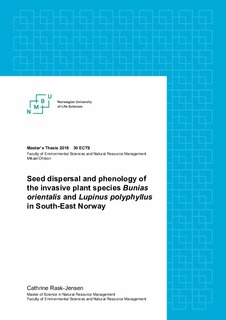| dc.description.abstract | The alien, invasive species Bunias orientalis and Lupinus polyphyllus are in expansion in Norway and pose an ecological threat to native species. The species form large and dense populations on wastelands, previous agricultural land, and along linear, anthropogenic structures like railways and road sides. L. polyphyllus reproduce primarily by seeds, but also via vegetative propagation. One plant can produce hundreds of seeds, which can be viable after 50 years. B. orientalis produce 200-5000 seeds per individual, and reproduce by seeds only. The aim of this study was to improve knowledge on seed dispersal ability of Bunias orientalis and Lupinus polyphyllus and to document their flowering and seed production phenology, which are relevant for future control of the species. The seed dispersal and phenology study were implemented at two sites of L. polyphyllus in Ås, and two sites of B. orientalis in Oslo. Three source populations of 3x3 m2 were fixed randomly at each site. A total of eight seed traps were placed in a straight line in the cardinal directions north - south at each side of the source population in respectively 0.5, 1, 2 and 4 meters distance. The source population functioned as a source for seed dispersal, as every individual of the target species outside, were cut down. The seed traps were emptied throughout the assessment period. Estimates of total mean seed production per source population were calculated to evaluate how much seeds were caught in the traps. The significance of cardinal direction regarding seed dispersal, and the species-specific differences in seed dispersal distances per species, were tested statistically. To obtain information on the distribution of seed dispersal throughout the season, when the predominance occurred and how long it transpired, fruits were counted on three individuals per source population each week. The dispersal of fruits was recorded through the decrease in fruits per individual. Simultaneously, the pods and siliquae were divided into the stages of flower, unripe, medium ripe and ripe to document the phenology of the target species. The phenology study provides approximate estimates of when the life cycle events can be presumed to occur for populations of the target species in SE Norway, though it vary annually. Control and management of the species should take place during the inflorescence, which in this study ended around 15.07 for both species. The results indicated that the ripening process and dispersal of fruits of the target species were very reciprocal to climate and habitat factors, and will probably be expedited with future climate changes. Despite extensive seed production in all source populations, there were few seeds caught in the traps, mostly at 0.5 and 1 meters distance. There was a significant difference in seed dispersal to the different trap distances for L. polyphyllus, however, not for B. orientalis. The occurrence of insect and rodent activity around the traps at the sites of L. polyphyllus, indicated that the species were dependent upon zoochory. Furthermore, compared to from the target species, there were more seeds of other species caught in the traps, at all sites. This was also, presumably due to that seeds of the target species were transported outside the traps, considered that L. polyphyllus and B. orientalis have a successful expansion, and mainly reproduce by seeds. The results indicated that the seed dispersal ability of L. polyphyllus and B. orientalis not was very efficient. Dispersal are probably highly effectuated by slipstreams from e.g. vehicles or trains, and germplasm being transported by vehicles or humans contribute to spread. The target species would not have been so effectively dispersed and managed to pose a threat to endemic species, if it was not for human intervention, and is otherwise dependent upon zoochory for dispersal of seeds. | nb_NO |

